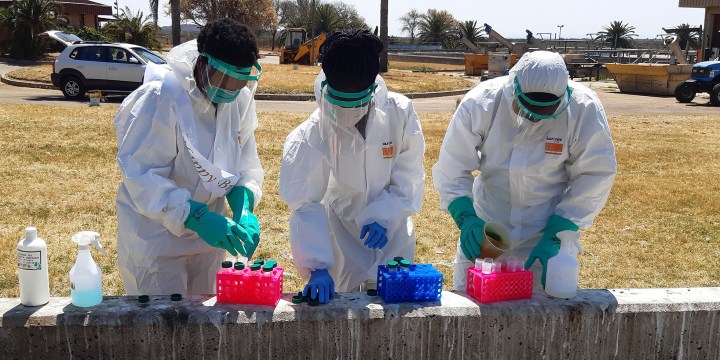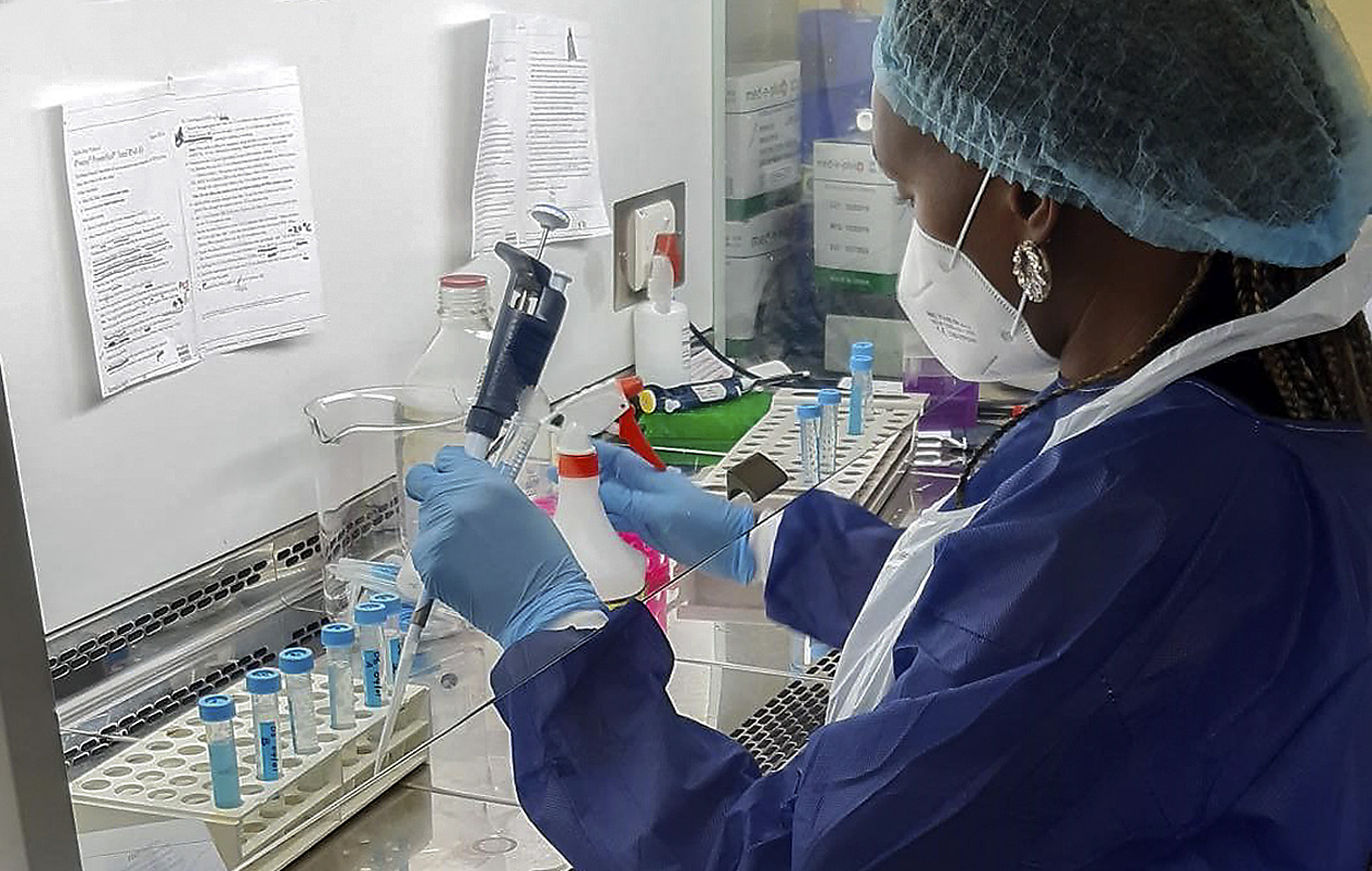SPOTLIGHT
Wastewater surveillance could help spot a third Covid-19 wave

Wastewater surveillance can be a useful part of a broader Covid-19 response strategy to track trends of Covid-19, but it should not be used in isolation.
As part of a project that started in July 2020, every week staff from the South African Medical Research Council (SAMRC) wastewater surveillance programme collect samples from wastewater treatment plants in the Eastern Cape, Western Cape, Limpopo and Gauteng. These samples are tested for fragments of SARS-CoV-2, the virus that causes Covid-19.
The data generated in this way is shared with the public on a dashboard on the SAMRC website that is updated weekly. If a substantial third wave of Covid-19 is to hit South Africa, chances are it will be evident in this data.

Results for each wastewater treatment plant are aggregated and presented as the RNA copies per millilitre found in the wastewater samples. (Photo: SAMRC / Spotlight)
Early warning system
“Wastewater has historically been used as an early warning system to identify various pathogens, including polio and hepatitis. This same concept can now be used in the detection of Covid-19 in wastewater,” explains Dr Renée Street, a specialist scientist in the environment and health research unit at the SAMRC.
“Wastewater surveillance can be a useful part of a broader Covid-19 response strategy to track trends of Covid-19, but it should not be interpreted in isolation,” she says.
“Shedding of the SARS-CoV-2 virus that causes Covid-19 may happen soon after a person is infected, both in asymptomatic and symptomatic cases. But there can be a delay in the first signs and symptoms before a person gets tested for Covid-19 and another delay before test results are available,” she says.
“In fact, some people who are infected never show symptoms (asymptomatic) and therefore may never get tested.”
But as Street points out, whether or not people show symptoms, they can shed the virus and this can then be detected in wastewater.
“Wastewater surveillance is monitoring the levels of SARS-CoV-2 RNA fragments (parts of the virus) in wastewater and gives us an indication of the caseload of Covid in the population,” explains Dr Natacha Berkowitz, an epidemiologist with the City of Cape Town. The city has been at the forefront of the country’s wastewater surveillance efforts.
Berkowitz says this surveillance may alert us to the possibility of a third wave, as people can excrete virus for as long as two weeks before showing symptoms.
“If we start getting very high levels of virus in the wastewater, that would make one concerned. However, we are still analysing the utility of this data to better understand what level of viral RNA would alert us to a resurgence,” she says.
She says they still need to compare the data to the caseload in the population. “This will help us decide what level of viral RNA detection would alert us to a resurgence.
“Additionally, people move around (for work, and so on), so high levels in one treatment works may not accurately reflect the caseload in its drainage area. High viral RNA levels also need to be standardised against population figures and flow rates.”
Collecting samples
Dr Awelani Mutshembele, a microbiologist at the SAMRC, says that early in the morning, she and her team at the SAMRC pack cooler boxes and put personal protective equipment (PPE) in the vehicle.
“At the first treatment plant, we put on the PPE which consists of overalls, gumboots, face shield, gloves. We collect the samples, pack them on ice, and drive to the next site. We usually collect from 10 plants on a normal day. At 1.30pm we are back at the laboratory,” she says.
“You don’t [want to] go there… you smell it from the gate. Just as you go around the treatment plant, when you open the car windows, already the flies [are] flying all over. At the plant, you see things that people flush out. Sometimes it’s funny, sometimes it is not,” she says, explaining that water samples are not being used, but the raw sewage as it enters the sewage treatment plant.
“It is important to note that samples are taken from the influent (wastewater going into the plant) and not the effluent,” says Berkowitz. “Studies have been conducted that show no active SARS-CoV-2 is found in the effluent (treated water) and this wastewater is not infectious.”

Wastewater surveillance has become an important part of South Africa’s Covid-19 monitoring systems. (Photo: SAMRC / Wikipedia)
Street adds that wastewater includes faeces and urine from the catchment communities and, there is no evidence that anyone has become sick with Covid-19 because of exposure to wastewater.
“For this project, the field staff receive training prior to commencement of sample collection and are also provided with a specially drafted wastewater sampling guide. Once on-site, personal protective equipment is worn at all times during collection and handling of the wastewater. In line with standard practice, staff in direct contact with wastewater samples are vaccinated against specified diseases,” she says.
Mutshembele says there is no best day or time to collect wastewater samples. “For surveillance and research purposes, it is best to always collect at the same time and on the same days. If one collects once a week or more or less often depends on the purpose of the research and on resources available to process the samples.”
At the lab
Mutshembele says they collect samples in 500ml bottles and put them inside a cooler box with ice packs, and when they get to the lab, they aliquot (adding into) to 50ml tubes and centrifuge (separating heavy material to liquid to settle down) and apply the RNA extraction kit.
Street says this analysis happens at SAMRC or partner university-based laboratories.
“The laboratory confirms the presence (qualitative analysis) and determines the RNA copy number of SARS-CoV-2 viral RNA by reverse transcriptase-polymerase chain reaction (RT-PCR) (quantitative) analysis.
“Results for each wastewater treatment plant are then aggregated and presented as the RNA copies per millilitre (RNA copies/ml) found in the wastewater samples. The results are uploaded onto the dashboard within 48 hours of collection,” she says.
Street says wastewater testing thus allows for the screening of hundreds and thousands of people with a single wastewater sample, which makes it a relatively cost-effective alternative to mass clinical testing of communities.
“A SARS-CoV-2 early warning system could be of particular importance for low- and middle-income countries where resources may be limited,” says Street.
“An effective early warning system could be used to identify Covid-19 hotspots, and guide action and the distribution of resources, including testing, tracing and preparedness strategies for Covid-19.”

The SAMRC team visits wastewater treatment plants in the early morning to collect samples as part of the wastewater surveillance programme to help track Covid-19. (Photo: SAMRC / Spotlight)
Tracking other diseases
Street says that wastewater surveillance can be used for a range of pathogens, including polio and measles, but also extends to other areas of research including pharmaceutical and illicit drug use.
“If pathogens can be found in stool or urine (like SARS-CoV-2), then this is a good starting point – but not all pathogens are suitable for wastewater surveillance,” she says.
“The process is not the same for all diseases,” explains Mutshembele.
“For example, with a virus, you extract RNA, whereas for bacteria you extract DNA. For bacterial infections, you will need another method but they do not differ much when using the kit. It is a matter of following the procedures.
“Viruses like norovirus, adenovirus and poliovirus, and bacteria like Escherichia coli, Salmonella species pluralis (ssp), Campylobacter spp, and vibrio cholerae are better suited for such tracking. These are organisms that are carried in the gut that can be coughed up and then swallowed like SARS-CoV-2.” DM
This article was produced by Spotlight – health journalism in the public interest.
"Information pertaining to Covid-19, vaccines, how to control the spread of the virus and potential treatments is ever-changing. Under the South African Disaster Management Act Regulation 11(5)(c) it is prohibited to publish information through any medium with the intention to deceive people on government measures to address COVID-19. We are therefore disabling the comment section on this article in order to protect both the commenting member and ourselves from potential liability. Should you have additional information that you think we should know, please email [email protected]"



 Become an Insider
Become an Insider